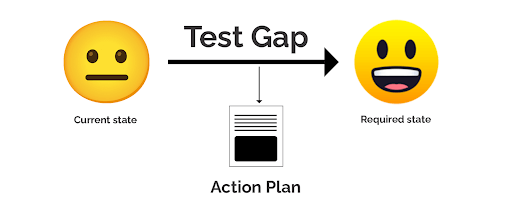Gap Analysis in Software Testing


The software development industry places significant importance on testing software products due to the potential negative consequences of releasing untested software. This can result in poor user experiences and harm a company’s reputation. To ensure comprehensive testing of all aspects of a product before its release, organizations prioritize conducting a test gap analysis. This analysis identifies deficiencies in their testing processes and allows for necessary improvements to be made. Through this approach, organizations can enhance the customer experience and ultimately bolster their reputation.
What is a test gap analysis?
Gap analysis, also known as gap test, identifies disparities between what is delivered and what is required in software testing. The terms “Where we are” and “Where we need to be” are commonly used to describe this process. This analysis helps to pinpoint any gaps, issues, or discrepancies between those two points, which can then be addressed to enhance the quality of the software.

The following are the fundamental steps of a gap analysis:
- Analyze the software requirements to determine the criteria against which the software will be tested.
- Plan the testing approach by creating test cases and test scenarios based on the identified requirements.
- Execute the tests according to the plan to determine if the software meets the established criteria.
- Analyze the results of the tests to identify any gaps between the desired outcome and the actual outcome. These gaps should be documented and prioritized for corrective action.
Importance of the Gap Analysis
In the realm of software testing, gap analysis is a crucial tool that enables organizations to assess the variance between their current testing practices and their desired level of testing quality. By identifying any gaps or deficiencies in their testing processes, organizations can implement improvements and ensure their software products meet established standards and requirements. Through gap analysis, organizations can prioritize the necessary enhancements to their testing process, ultimately leading to improved software quality and better customer satisfaction.
In addition, gap analysis plays a vital role in selecting the appropriate tools and methodologies used during the testing process, leading to higher accuracy in test data. Regular gap analysis is also beneficial in identifying and resolving possible security vulnerabilities, helping organizations ensure the reliability and security of their software products. By conducting gap analysis, organizations can elevate their testing process, improve software quality, and ultimately enhance both their reputation and customer experience.
How to conduct a gap analysis in software testing?
There are several ways to perform a gap analysis in software testing, and through this article, we will discuss some of the methods and tools we can use to conduct a gap analysis efficiently.
Methods to conduct a gap analysis.
Multiple methods exist for performing gap analyses in software testing. Here are some examples:
Test Analytics
Test analytics involves the collection and analysis of data from software testing to improve software quality. It includes measuring the performance, reliability, and effectiveness of testing activities using various tools and techniques. Moreover, gap analysis can also be performed through test analytics. Here are the steps for conducting gap analysis using this technique:
- Define the desired testing state or the benchmark for testing quality.
- Collect relevant test data using various tools and techniques.
- Analyze the collected data using statistical methods and data mining techniques to identify areas where the actual testing falls short of the desired state.
- Identify gaps in the testing process or areas where improvements are necessary to achieve the desired state.
- Define an action plan to close the identified gaps, prioritizing the most crucial areas for improvement first.
By following these steps to conduct a gap analysis, organizations can enhance the quality of their software products and minimize the potential risks of defects during production.
Code Quality Testing
Code quality can be evaluated in several ways, including assessing its readability, maintainability, efficiency, and adherence to coding standards and best practices. This process can also be utilized to conduct gap analysis in software testing with the following steps:
- Define the code quality standards and requirements that are essential for the software product.
- Choose appropriate tools, such as unit testing frameworks, code review tools, and static code analysis tools, to evaluate the code quality.
- Evaluate the current code quality against the predefined standards and requirements.
- Analyze the results using the selected tools to identify areas where code quality falls short.
- Prioritize the identified gaps based on their impact on the system.
- Develop an action plan to address the identified gaps and improve code quality.
- Monitor the progress of the plan and revise the steps if necessary to ensure that the gaps are closed effectively.

By following these steps, code quality testing can be used for gap analysis, ensuring that the software product meets its defined code quality standards and requirements.
Code Quality Measurement
This method is distinct from the previous one, as it uses quantitative and qualitative metrics to evaluate the quality of software code, such as maintainability, complexity, security, and performance. The following steps can be used to conduct gap analysis using this method:
- Define quality metrics, such as code complexity, performance, security, and maintainability, that are essential for the software product.
- Select appropriate tools, such as code analyzers, quality visualization tools, code complexity tools, profiling tools, dependency tools, and code coverage tools, to conduct this method.
- Measure the code quality using the selected tools.
- Analyze the results to identify gaps in the code quality.
- Prioritize the identified gaps based on their severity and potential impact on the system.
- Develop an action plan to address the identified gaps and improve code quality.
- Monitor the progress of the plan and revise the steps if necessary to ensure that the gaps are addressed effectively.

Apart from the aforementioned methods, there are various other ways to conduct gap analysis in software testing.
Tools to conduct a gap analysis.
There are several tools available for performing gap analyses in software testing. Here are some of the tools that can be used for this purpose:
Traceability matrix.
A traceability matrix is a document that typically consists of a grid that links the requirements with the corresponding test cases. The rows of the matrix represent the requirements, while the columns indicate the test cases. In the matrix, each cell represents whether a specific test case has covered a particular requirement or need.
To use a traceability matrix for gap analysis,
- Identify the requirements that are to be tested.
- Create a traceability matrix.
- Execute the test cases and record the results in the traceability matrix.
- Analyze the results in the traceability matrix to identify any gaps or discrepancies.
- Determine the cause of the gaps.
- Develop an action plan to address the gaps.
- Implement the plan and re-run the tests.
- Repeat the analysis to ensure that all gaps have been addressed.
We can successfully perform a gap analysis using a traceability matrix by completing these steps.
Below are some sample traceability matrix templates.


Test coverage analysis tools.
Test coverage analysis tools are used to analyze software’s source code and identify the parts of the code that have been executed during testing. In addition, these tools can be used to conduct a gap analysis in software testing by analyzing the extent to which the software has been tested against its requirements.
To use these tools for gap analysis,
- Identify the requirements of the software that require testing.
- Create a suite of test cases that cover these requirements.
- Use a test coverage analysis tool to analyze the test results and generate a report on the coverage achieved. The report will show which requirements have been fully tested, which have been partially tested, and which have not been tested.
- Identify gaps in the testing and highlight areas where additional testing is required.
- Develop an action plan and execute it to close the gaps.
Examples: JaCoCo, Emma, Cobertura, Istanbul, Codecov.

Defect tracking tools.
Defect tracking tools play a critical role in the software development process by capturing and reporting defects, assigning tasks to team members, and monitoring the progress of defect resolution. These tools can be effectively used for conducting gap analysis in software testing. To use these tools for gap analysis,
- Identify the areas of the software product that require evaluation.
- Create a project or a separate issue tracker within the defect tracking tool for the gap analysis project.
- Define the criteria for the gap analysis and create test cases or checklists that will help us evaluate each criterion.
- Execute the test cases or checklists and record the results in the defect tracking tool.
- Analyze the results to identify gaps or discrepancies in the software product. We can use filters or custom reports in the defect tracking tool to generate data visualizations and summaries.
- Create issues or defects for the gaps identified, assign them to the relevant team members, and track their resolution using the defect tracking tool.
Following these steps, we can use the defect tracking tools to conduct an effective gap analysis in software testing.
Example tools: JIRA, Bugzilla, MantisBT, Redmine, Trac.

Risk analysis tools.
Risk analysis tools are used to document and assess risks associated with the software product, such as potential technical or business risks. These tools can help prioritize risks based on their impact and likelihood of occurrence.
- Identify the risks associated with the software using a risk analysis tool.
- Assess the risks by assigning scores to each risk based on its probability and severity.
- Prioritize the risks based on their scores.
- Identify the current state and the desired state.
- Identify the gaps by comparing the current state and the desired state.
- Develop an action plan to address the gaps and execute it.
- Repeat the analysis to confirm that all the gaps are closed.
Through these steps, we can use risk analysis tools to conduct a gap analysis.
Examples: RiskyProject, Riskalyze, Palisade @RISK, Risk Management Studio, Oracle Primavera Risk Analysis.

Conclusion
Software testing is a critical process in software development, and gap analysis helps organizations identify discrepancies between the current and desired states of testing. By evaluating gaps, organizations can improve their testing process to meet their goals and deliver high-quality software products. There are various tools available that can be used for gap analysis in software testing, providing valuable insights to prioritize efforts to improve software quality, reduce errors, and increase customer satisfaction. Conducting a regular gap analysis is highly recommended to ensure software reliability, security, and usability.


